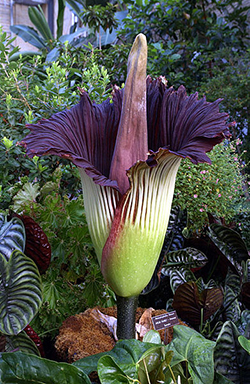Biology Greenhouse now home to three corpse plants

Greenhouse technician Arthur Yeas with the 50-pound corm of the corpse plant. Yeas planted three corms this week, and will know early next year if the plant will flower or leaf.
The Biology Greenhouse is now growing the world’s smelliest flower.
Greenhouse technician Arthur Yeas planted three 50-pound corms (large bulbs) of the Amorphophallus Titanum – better known as the corpse plant – this week.
When it flowers, the plant’s foul smell can be detected by humans from up to a mile away – but there’s no guarantee that will ever happen.

In fact, there have only been 200 documented flowerings of the cultivated corpse plant since 1886, and only two in Canada.
The plant is native to the Island of Sumatra, Indonesia, and is listed as vulnerable by the International Conservation of Nature.
“They are very rare,” says Yeas, who earlier this year tended to a related, nearly-as-smelly plant, the Devil’s tongue. “It’s a great addition to our collection and for students to see. It helps us realize the incredible diversity of the natural world, and emphasizes the need to conserve plants and biodiversity.”
In addition to its pungent, rotting flesh-like odour – used to attract pollinators like carrion beetles and flesh flies – the plant is also massive.
The tallest on record was ten feet high and three metres around, and when dormant the plant produces the largest leaf in the world, measuring up to six metres tall and nearly five metres in diameter.
It won’t be until early next year that Yeas will be able to determine whether the plants are going to leaf or flower.
